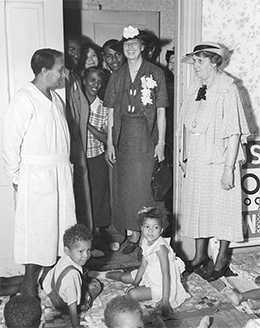| << Chapter < Page | Chapter >> Page > |

Historians agree that the first lady used her presence in the White House, in addition to the leverage of her failed marriage and knowledge of her husband’s infidelities, to her advantage. She promoted several causes that the president himself would have had difficulty championing at the time. From newspaper and magazine articles she authored, to a busy travel schedule that saw her regularly cross the country, the first lady sought to remind Americans that their plight was foremost on the minds of all working in the White House. Eleanor was so active in her public appearances that, by 1940, she began holding regular press conferences to answer reporters’ questions. Among her first substantial projects was the creation of Arthurdale—a resettlement community for displaced coal miners in West Virginia. Although the planned community became less of an administration priority as the years progressed (eventually folding in 1940), for seven years, Eleanor remained committed to its success as a model of assistance for the rural poor.
Exposed to issues of racial segregation in the Arthurdale experiment, Eleanor subsequently supported many civil rights causes through the remainder of the Roosevelt presidency. When it further became clear that racial discrimination was rampant in the administration of virtually all New Deal job programs—especially in the southern states—she continued to pressure her husband for remedies. In 1934, she openly lobbied for passage of the federal anti-lynching bill that the president privately supported but could not politically endorse. Despite the subsequent failure of the Senate to pass such legislation, Eleanor succeeded in arranging a meeting between her husband and then-NAACP president Walter White to discuss anti-lynching and other pertinent calls for civil rights legislation.
White was only one of Eleanor’s African American guests to the White House. Breaking with precedent, and much to the disdain of many White House officials, the first lady routinely invited prominent African Americans to dine with her and the president. Most notably, when the Daughters of the American Revolution (DAR) refused to permit internationally renowned black opera contralto Marian Anderson to sing in Constitution Hall, Eleanor resigned her membership in the DAR and arranged for Anderson to sing at a public concert on the steps of the Lincoln Memorial, followed by her appearance at a state dinner at the White House in honor of the king and queen of England. With regard to race relations in particular, Eleanor Roosevelt was able to accomplish what her husband—for delicate political reasons—could not: become the administration’s face for civil rights.
Despite his popularity, Roosevelt had significant critics at the end of the First New Deal. Some on the right felt that he had moved the country in a dangerous direction towards socialism and fascism, whereas others on the left felt that he had not gone far enough to help the still-struggling American people. Reeling after the Supreme Court struck down two key pieces of New Deal legislation, the AAA and NIRA, Roosevelt pushed Congress to pass a new wave of bills to provide jobs, banking reforms, and a social safety net. The laws that emerged—the Banking Act, the Emergency Relief Appropriation Act, and the Social Security Act—still define our country today.
Roosevelt won his second term in a landslide and continued to push for legislation that would help the economy. The jobs programs employed over eight million people and, while systematic discrimination hurt both women and African American workers, these programs were still successful in getting people back to work. The last major piece of New Deal legislation that Roosevelt passed was the Fair Labor Standards Act, which set a minimum wage, established a maximum-hour workweek, and forbade child labor. This law, as well as Social Security, still provides much of the social safety net in the United States today.
While critics and historians continue to debate whether the New Deal ushered in a permanent change to the political culture of the country, from one of individualism to the creation of a welfare state, none deny the fact that Roosevelt’s presidency expanded the role of the federal government in all people’s lives, generally for the better. Even if the most conservative of presidential successors would question this commitment, the notion of some level of government involvement in economic regulation and social welfare had largely been settled by 1941. Future debates would be about the extent and degree of that involvement.

Notification Switch
Would you like to follow the 'U.s. history' conversation and receive update notifications?